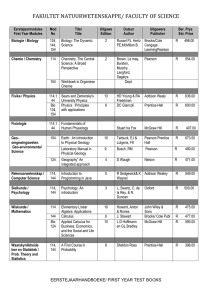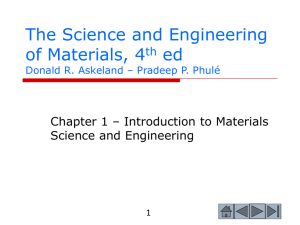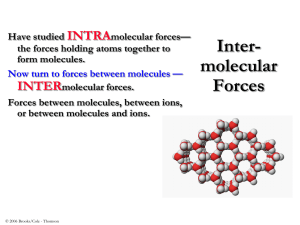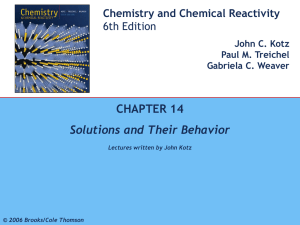Unit 6 Lecture 3 Electrolysis
advertisement
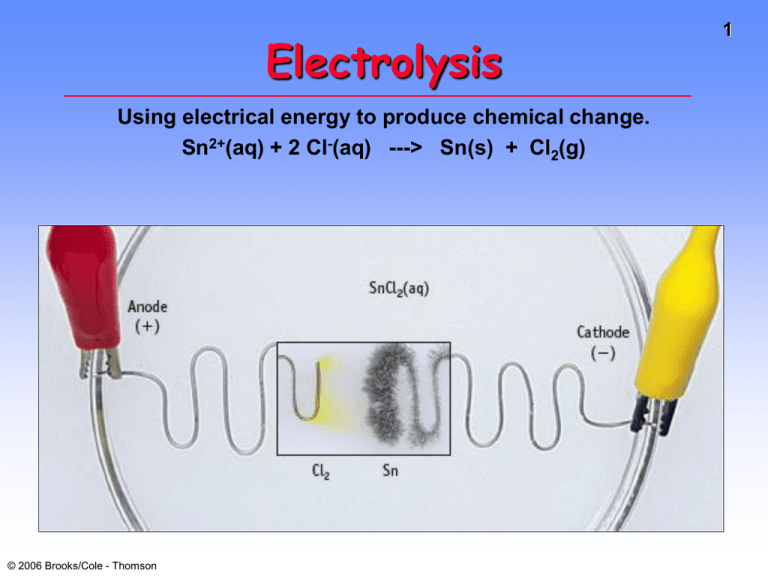
Electrolysis Using electrical energy to produce chemical change. Sn2+(aq) + 2 Cl-(aq) ---> Sn(s) + Cl2(g) © 2006 Brooks/Cole - Thomson 1 Electrolysis Electric Energy ---> Chemical Change • Electrolysis of molten NaCl. • Here a battery “pumps” electrons from Cl- to Na+. • NOTE: Polarity of electrodes is reversed from batteries. © 2006 Brooks/Cole - Thomson 2 Electrolysis of Molten NaCl Figure 20.18 © 2006 Brooks/Cole - Thomson 3 Electrolysis of Molten NaCl Anode (+) 2 Cl- ---> Cl2(g) + 2eCathode (-) Na+ + e- ---> Na Eo for cell (in water) = - 4.07 V (in water) External energy needed because Eo is (-). © 2006 Brooks/Cole - Thomson 4 Electrolysis of Aqueous NaI Anode (+): 2 I- ---> I2(g) + 2eCathode (-): 2 H2O + 2e- ---> H2 + 2 OHEo for cell = -1.36 V © 2006 Brooks/Cole - Thomson 5 Electrolysis of Aqueous CuCl2 Anode (+) 2 Cl- ---> Cl2(g) + 2eCathode (-) Cu2+ + 2e- ---> Cu Eo for cell = -1.02 V Note that Cu2+ is more easily reduced than either H2O or Na+. © 2006 Brooks/Cole - Thomson 6 Michael Faraday 1791-1867 Originated the terms anode, cathode, anion, cation, electrode. Discoverer of • electrolysis • magnetic props. of matter • electromagnetic induction • benzene and other organic chemicals Was a popular lecturer. © 2006 Brooks/Cole - Thomson 7 Quantitative Aspects of Electrochemistry Consider electrolysis of aqueous silver ion. Ag+ (aq) + e- ---> Ag(s) 1 mol e- ---> 1 mol Ag If we could measure the moles of e-, we could know the quantity of Ag formed. But how to measure moles of e-? © 2006 Brooks/Cole - Thomson 8 Quantitative Aspects of Electrochemistry But how is charge related to moles of electrons? = = 96,500 C/mol e1 Faraday Michael Faraday 1791-1867 © 2006 Brooks/Cole - Thomson 9 Quantitative Aspects of Electrochemistry 1.50 amps flow through a Ag+(aq) solution for 15.0 min. What mass of Ag metal is deposited? Solution (a) Calc. charge Charge (C) = current (A) x time (t) = (1.5 amps)(15.0 min)(60 s/min) = 1350 C © 2006 Brooks/Cole - Thomson 10 Quantitative Aspects of Electrochemistry 1.50 amps flow through a Ag+(aq) solution for 15.0 min. What mass of Ag metal is deposited? Solution (a) Charge = 1350 C (b) Calculate moles of e- used (c) Calc. quantity of Ag © 2006 Brooks/Cole - Thomson 11 Quantitative Aspects of Electrochemistry The anode reaction in a lead storage battery is Pb(s) + HSO4-(aq) ---> PbSO4(s) + H+(aq) + 2eIf a battery delivers 1.50 amp, and you have 454 g of Pb, how long will the battery last? Solution a) 454 g Pb = 2.19 mol Pb b) Calculate moles of e- c) Calculate charge 4.38 mol e- • 96,500 C/mol e- = 423,000 C © 2006 Brooks/Cole - Thomson 12 Quantitative Aspects of Electrochemistry 13 The anode reaction in a lead storage battery is Pb(s) + HSO4-(aq) ---> PbSO4(s) + H+(aq) + 2eIf a battery delivers 1.50 amp, and you have 454 g of Pb, how long will the battery last? Solution a)454 g Pb = 2.19 mol Pb b) Mol of e- = 4.38 mol c)Charge = 423,000 C d) Calculate time About 78 hours © 2006 Brooks/Cole - Thomson






